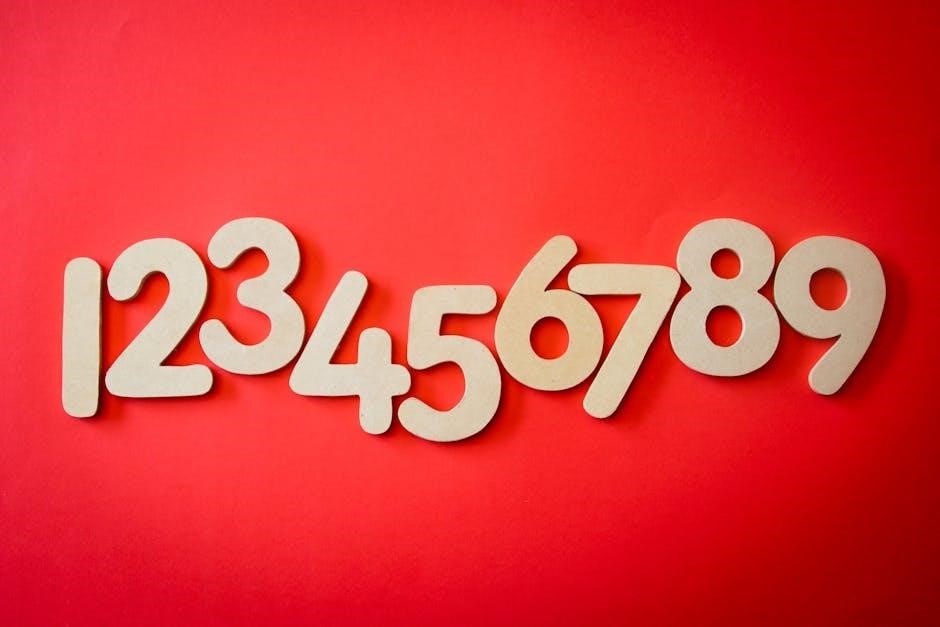common core math grade 5 pdf
Summary
Download free Common Core Math Grade 5 worksheets and exercises in PDF format. Perfect for students, parents, and teachers to practice and master math skills!

The Common Core Math Grade 5 PDF provides comprehensive resources for mastering critical math skills, including fraction operations, multi-digit calculations, and practical problem-solving strategies for students.
1.1 Overview of the Common Core Math Standards
The Common Core Math Standards for Grade 5 focus on building a strong foundation in critical areas such as fraction operations, multiplication, division, and understanding volume and area. These standards emphasize fluency, application, and deep conceptual understanding. Students are expected to use equivalent fractions to add and subtract, extend multiplication and division to fractions, and solve real-world problems. The standards also highlight the importance of mathematical practices, such as making sense of problems, reasoning abstractly, and constructing viable arguments. By mastering these skills, students prepare for more complex math in higher grades, ensuring they can apply math to solve practical challenges and think critically in various contexts.
1.2 Importance of Grade 5 Math in the Common Core Curriculum
Grade 5 math plays a pivotal role in the Common Core curriculum as it bridges foundational skills to more advanced concepts. It emphasizes mastery of fractions, multi-digit operations, and real-world problem-solving, ensuring students transition smoothly to middle school mathematics. This grade focuses on critical thinking, fluency, and application, preparing students for higher-level math and science. The curriculum’s structure supports long-term academic success by fostering a deep understanding of numerical relationships and practical problem-solving strategies. Grade 5 serves as a cornerstone, enabling students to approach complex challenges with confidence and a solid mathematical foundation.
1.3 Structure of the Grade 5 Math PDF Resources
The Grade 5 Math PDF resources are organized to provide a comprehensive learning experience. Each unit begins with mini-lessons that introduce key concepts, followed by practice pages offering three levels of difficulty. These levels cater to differentiated instruction, ensuring all students can engage with the material. Word problems are integrated throughout to promote real-world application of skills. The PDFs include visual models, such as fraction diagrams and number lines, to aid understanding. Additionally, review materials and assessments are included to reinforce learning and prepare students for evaluations. This structured approach aligns with Common Core standards, ensuring a balanced mix of instruction, practice, and assessment to support student mastery of mathematical concepts.

Critical Areas of Focus in Grade 5 Math
Grade 5 math focuses on three critical areas: fraction operations, extending multiplication and division, and understanding volume and area to build a strong mathematical foundation for students.
2.1 Developing Fluency with Fraction Operations
Developing fluency with fraction operations is a key focus in Grade 5 math. Students learn to add, subtract, multiply, and divide fractions, including mixed numbers and improper fractions. Visual models and real-world applications help students understand these concepts deeply. The Common Core emphasizes using equivalent fractions to solve problems and simplifying fractions to their lowest terms; This skill is essential for preparing students to tackle more complex mathematical concepts in higher grades. By mastering fraction operations, students build a strong foundation for algebra and advanced problem-solving. Regular practice and differentiated instruction ensure all learners achieve proficiency in this critical area of mathematics.
2.2 Extending Understanding of Multiplication and Division
In Grade 5, students extend their understanding of multiplication and division to solve multi-digit and real-world problems. They apply strategies such as partial products, area models, and the distributive property to multiply multi-digit numbers. Division is explored through concepts like quotients, remainders, and interpreting results in context. Students also connect multiplication and division to fractions, understanding how division relates to finding quotients of fractions. Real-world applications and visual models enhance their comprehension. This focus builds on earlier skills, ensuring students can apply these operations flexibly and accurately. Mastery of these concepts is crucial for advancing to more complex mathematical ideas in higher grades. Regular practice and problem-solving activities reinforce their understanding and fluency.
2.3 Understanding Volume and Area
In Grade 5, students explore the concepts of volume and area, building foundational skills for geometry and measurement. Volume is introduced as the space inside a three-dimensional shape, calculated using multiplication of length, width, and height. Area is defined as the surface space of a two-dimensional shape, often determined by decomposing shapes into simpler components like rectangles. Practical applications, such as measuring real-world objects, help students connect these concepts to everyday scenarios. Visual models and formulas are emphasized to deepen understanding. Mastery of volume and area prepares students for more complex geometric calculations in higher grades, fostering problem-solving skills and spatial awareness. Interactive activities and real-world problems enhance their ability to apply these concepts effectively. This focus ensures students develop a strong foundation in measurement and geometry.

Number and Operations in Base Ten
This section focuses on understanding place value, performing operations with multi-digit numbers, and converting between different forms of numbers, building foundational skills for higher-level mathematics.
3.1 Understanding Place Value
Understanding place value is a foundational skill in the Common Core Math Grade 5 curriculum. Students learn to recognize the value of each digit in a multi-digit number, such as hundreds, tens, and ones. This concept is extended to decimals, where understanding tenths, hundredths, and thousandths is introduced. The curriculum emphasizes the importance of place value in performing operations like addition, subtraction, multiplication, and division. By mastering place value, students can better comprehend how numbers relate to one another and apply this knowledge to solve real-world problems. Visual models, such as place value charts and base-ten blocks, are frequently used to help students visualize and internalize these concepts. This skill is essential for advancing to more complex mathematical operations in higher grades.
3.2 Performing Operations with Multi-Digit Numbers
Performing operations with multi-digit numbers is a key focus in the Common Core Math Grade 5 curriculum; Students are expected to add, subtract, multiply, and divide multi-digit numbers accurately. The curriculum emphasizes the use of standard algorithms, such as the column method for addition and subtraction, and the area model or standard algorithm for multiplication and division. These operations are applied to real-world problems, helping students develop fluency and problem-solving skills. The ability to perform these operations is foundational for more complex math in higher grades, ensuring students can tackle challenges like ratios, percentages, and algebraic expressions with confidence. Practice worksheets and interactive tools are often provided to reinforce these skills.
3.3 Converting Between Different Forms of Numbers
Converting between different forms of numbers is a fundamental skill in the Common Core Math Grade 5 curriculum. Students learn to convert whole numbers to fractions, decimals, and percentages, as well as change fractions to mixed numbers or improper fractions. This skill enhances number sense and prepares students for more complex calculations. For example, understanding that 0.5 is equivalent to 1/2 or 50% is crucial for solving real-world problems. Practice worksheets and interactive tools in the Grade 5 Math PDF resources provide opportunities for students to master these conversions, ensuring they can apply this knowledge across various mathematical contexts with accuracy and confidence.

Fractions in Grade 5 Math
Fractions in Grade 5 involve adding, subtracting, multiplying, and dividing fractions, including converting between mixed numbers and improper fractions. Students also simplify fractions to their lowest terms.
4.1 Adding and Subtracting Fractions
In Grade 5, students learn to add and subtract fractions with unlike denominators by finding equivalent fractions. They apply this skill to solve real-world problems and use visual models to aid understanding. The Common Core emphasizes using benchmark fractions to estimate and assess the reasonableness of answers. For example, students might add 1/3 and 2/4 by converting them to 4/12 and 6/12, resulting in 10/12. This process reinforces the concept of equivalent fractions and prepares students for more complex operations. Practice worksheets and online resources provide ample opportunities for students to master these skills, ensuring they can apply them confidently in various mathematical scenarios.
4.2 Multiplying and Dividing Fractions
In Grade 5, students explore multiplying and dividing fractions, building on their understanding of fraction operations. They learn to multiply two fractions by multiplying the numerators and denominators separately and simplify the result. For division, students understand that dividing by a fraction is equivalent to multiplying by its reciprocal. Visual models, such as fraction bars, help students conceptualize these operations. Real-world applications, like calculating ingredients for recipes, make learning practical. The Common Core standards emphasize fluency and accuracy, ensuring students can apply these skills confidently. Printable PDF worksheets and online resources provide structured practice, reinforcing mastery of fraction multiplication and division. These skills are foundational for advanced math concepts in later grades.
4.3 Converting Between Mixed Numbers and Improper Fractions
Converting between mixed numbers and improper fractions is a fundamental skill in Grade 5 math. Students learn to convert mixed numbers, which combine whole numbers and fractions, into improper fractions, where the numerator is larger than the denominator. For example, 1 1/2 becomes 3/2 by multiplying the whole number by the denominator and adding the numerator. Similarly, improper fractions can be converted back to mixed numbers by dividing the numerator by the denominator. This process enhances understanding of fraction relationships and prepares students for more complex operations. Visual models and real-world applications, such as cooking measurements, help reinforce these concepts. Mastery of these conversions is essential for fluency in fraction operations, aligning with Common Core standards for mathematical proficiency.
4.4 Simplifying Fractions to Their Lowest Terms
Simplifying fractions to their lowest terms involves reducing the numerator and denominator by their greatest common divisor (GCD). This process ensures fractions are expressed in their simplest form, making calculations more efficient. For example, the fraction 6/8 can be simplified to 3/4 by dividing both the numerator and denominator by 2. This skill is crucial for operations like addition, subtraction, and multiplication of fractions. Visual models, such as fraction strips or area models, help students understand the concept of equivalent fractions and how simplification works. Real-world applications, like dividing a pizza or cake equally, provide practical context. Students also learn to recognize patterns and apply mathematical reasoning to verify simplification accuracy, aligning with Common Core standards for fraction proficiency and problem-solving strategies.

Measurement and Data
Students learn to convert units of measurement, calculate volume of rectangular prisms, and interpret data through line plots, developing essential skills in measurement and data analysis.
5.1 Converting Units of Measurement
Converting units of measurement is a fundamental skill in Grade 5 math. Students learn to switch between different units, such as inches to feet or cups to gallons, using conversion factors. This skill is essential for solving real-world problems, like measuring ingredients for a recipe or calculating distances for a road trip. The Common Core curriculum emphasizes understanding the relationships between units and applying conversion strategies accurately. Through practice, students develop fluency in converting units within the same system, ensuring they can handle more complex measurements as they progress in math.
5.2 Calculating Volume of Rectangular Prisms
Calculating the volume of rectangular prisms is a key concept in Grade 5 math, focusing on understanding three-dimensional space and capacity. Students learn to apply the formula: volume equals length multiplied by width and then by height (V = l × w × h). This skill helps solve real-world problems, such as determining the space inside a box or the amount of material needed for a construction project. The Common Core curriculum emphasizes visualizing the multiplication of dimensions and using unit cubes to build conceptual understanding. Through hands-on activities and problem-solving exercises, students develop proficiency in calculating volumes accurately and applying this knowledge to practical scenarios.
5.3 Understanding and Creating Line Plots

Understanding and creating line plots is a fundamental skill in Grade 5 math, focusing on organizing and displaying data effectively. A line plot, or number line plot, visually represents data points on a number line, showing the frequency of each value. Students learn to interpret and construct line plots to analyze distributions, identify patterns, and compare datasets. The Common Core curriculum emphasizes understanding how line plots relate to real-world scenarios, such as measuring the lengths of objects or tracking temperatures. By creating and interpreting line plots, students develop essential data analysis skills, including how to read and interpret graphical representations accurately. This concept builds a strong foundation for more advanced data analysis in higher grades.

Geometry in Grade 5
Grade 5 geometry focuses on identifying lines of symmetry, classifying shapes, and understanding their attributes. Students learn to measure and calculate volumes, solving real-world and mathematical problems effectively.
6.1 Identifying and Drawing Lines of Symmetry
In Grade 5, students learn to identify and draw lines of symmetry in various shapes. Symmetry is a fundamental concept in geometry where a shape can be divided into mirror-image halves. This skill enhances spatial reasoning and visualization abilities. Through hands-on activities, students explore both vertical and horizontal symmetry, recognizing patterns and applying mathematical reasoning. Practical exercises include folding paper shapes and creating symmetric designs, reinforcing their understanding of balance and proportion in geometric figures. These skills are essential for advanced geometry and real-world applications, making symmetry a crucial part of the Common Core Math curriculum for fifth graders.
6.2 Classifying Two-Dimensional Shapes
In Grade 5, students learn to classify two-dimensional shapes based on their attributes, such as the number of sides, angles, and vertices. This skill helps develop spatial awareness and logical reasoning. Students explore categories like triangles, quadrilaterals, pentagons, and hexagons, identifying specific types within each group, such as equilateral triangles or rectangles. They also learn to distinguish between shapes that are congruent or similar. Activities include using Venn diagrams and shape sorting exercises to organize shapes by their properties. Real-world applications, such as identifying shapes in architecture or nature, further reinforce these concepts. This foundation is critical for more advanced geometry studies in higher grades.

Mathematical Practices for Grade 5
Grade 5 students develop problem-solving skills, reasoning, and communication of mathematical ideas. These practices enhance critical thinking and apply to all math concepts, fostering deep understanding and proficiency.

7.1 Making Sense of Problems and Persevering
Making sense of problems and persevering is a cornerstone of Grade 5 math. Students learn to engage deeply with problems, understanding their underlying structures and persisting in solving them. This practice encourages critical thinking and resilience, teaching students not to shy away from challenges. By breaking problems into manageable parts and using visual models or diagrams, students develop a robust problem-solving approach. This practice also fosters a growth mindset, helping students view obstacles as opportunities to learn. Parents and educators can support this by encouraging students to explain their reasoning and explore multiple strategies. Perseverance in math builds confidence and prepares students for more complex concepts in later grades, ensuring they become proficient problem solvers.
7.2 Reasoning Abstractly and Quantitatively
Reasoning abstractly and quantitatively is a key practice in Grade 5 math, enabling students to think flexibly about problems. This skill involves understanding abstract concepts, such as fractions or multi-digit operations, and applying them to real-world scenarios. Students learn to break down complex problems into smaller, manageable parts, fostering deeper mathematical understanding. By using visual models, equations, or verbal explanations, students can explore different approaches to solve problems. This practice also encourages connecting mathematical ideas to practical applications, helping students see the relevance of math in everyday life. Developing these reasoning skills prepares students to tackle more advanced concepts and think critically in various situations, both in academics and beyond. This foundational ability is crucial for long-term math proficiency and problem-solving success.
7.3 Constructing Viable Arguments
Constructing viable arguments is a critical mathematical practice in Grade 5, where students learn to explain their reasoning and support it with evidence. This skill encourages students to communicate their thinking clearly and persuasively, using mathematical concepts and logic. By forming well-reasoned arguments, students develop a deeper understanding of math problems and solutions. They also learn to critique and refine their own arguments, as well as those of peers, fostering collaboration and critical thinking. This practice helps students become adept at justifying their answers and understanding different problem-solving approaches. It also prepares them to engage in mathematical discussions and defend their solutions effectively, both in academic settings and real-world scenarios, making it a cornerstone of mathematical literacy and problem-solving proficiency.
7.4 Using Tools Strategically
Using tools strategically in Grade 5 math enables students to solve problems efficiently and accurately. This practice encourages the appropriate use of manipulatives, such as fraction bars and geometric shapes, to visualize concepts. Students learn to employ rulers, protractors, and calculators when necessary, ensuring precision in measurements and calculations. By selecting the right tools for specific tasks, students develop problem-solving flexibility and critical thinking. This skill also fosters an understanding of when technology or physical models can enhance mathematical exploration. Strategic tool use helps students approach challenges with confidence, making their problem-solving processes more effective and systematic. It bridges the gap between abstract concepts and practical applications, preparing students for real-world mathematical scenarios.

Resources and Worksheets
Grade 5 Common Core math resources include printable PDF worksheets, online practice materials, and review guides. These tools provide structured exercises for skill mastery and assessment preparation.
8.1 Printable PDF Worksheets for Grade 5 Math
Printable PDF worksheets for Grade 5 Common Core math offer structured exercises to reinforce essential skills. These resources, such as those from the Diocese of Buffalo and Newmark Learning, include mini-lessons, practice pages, and word problems. They cover critical areas like fraction operations, multi-digit calculations, and geometry. Worksheets often feature differentiated instruction, catering to various learning levels. For example, they include exercises on adding and subtracting fractions, converting mixed numbers, and simplifying fractions. These PDFs are ideal for classroom use, homework, or review. They align with Common Core standards, ensuring students master key concepts. Parents and educators can easily download and print these materials, providing students with hands-on practice to build confidence and fluency in math.
8.2 Online Resources for Common Core Math Practice
Online resources for Common Core math practice provide interactive and engaging tools for Grade 5 students. Websites like thecorestandards;org and educational platforms offer printable worksheets, video tutorials, and adaptive assessments. These resources are designed to support learning at home or in the classroom. They cover topics such as fractions, geometry, and operations with multi-digit numbers. Many platforms, such as Pearson’s EnVision Math, include interactive activities that make learning fun and accessible. Parents and teachers can track progress and identify areas needing improvement. These online tools align with Common Core standards, ensuring students receive comprehensive practice. They cater to different learning styles, offering visual models and step-by-step explanations. Regular use of these resources helps build confidence and fluency in math skills, preparing students for success in higher grades.
8.3 Review Materials for End-of-Unit Assessments
Review materials for end-of-unit assessments in Grade 5 Common Core math are essential for reinforcing learning and preparing students for evaluations. These resources often include printable PDF worksheets that focus on key concepts such as fraction operations, multi-digit calculations, and geometry. Many materials, like those from the Diocese of Buffalo, provide step-by-step problem-solving guides and answers for self-assessment. Interactive tools and online platforms also offer quizzes and practice tests aligned with Common Core standards. These review materials help students identify areas needing improvement and build confidence before formal assessments. Additionally, they often include visual models and real-world applications to deepen understanding. Regular use of these resources ensures students are well-prepared for end-of-unit tests and long-term math success.